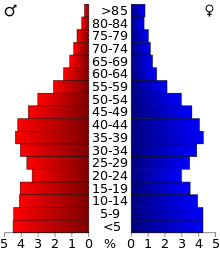Kane County, Illinois
Kane County is a county in the U.S. state of Illinois. According to the 2010 census, it has a population of 515,269,[2] making it the fifth-most populous county in Illinois. Its county seat is Geneva,[3] and its largest city is Aurora.
Kane County | |
|---|---|
County | |
| County of Kane | |
The Fabyan Windmill in Geneva is on the National Register of Historic Places in Kane County, Illinois. | |
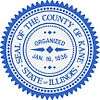 Seal | |
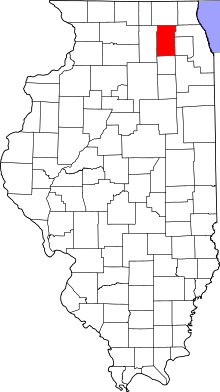 Location within the U.S. state of Illinois | |
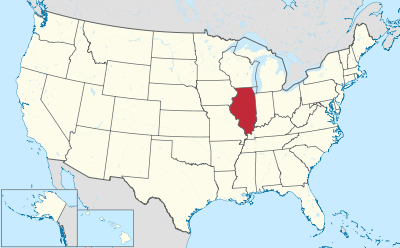 Illinois's location within the U.S. | |
| Coordinates: 41°57′N 88°26′W | |
| Country | |
| State | |
| Founded | January 16, 1836 |
| Named for | Elias Kane |
| Seat | Geneva |
| Largest city | Aurora |
| Area | |
| • Total | 524 sq mi (1,360 km2) |
| • Land | 520 sq mi (1,300 km2) |
| • Water | 4.1 sq mi (11 km2) 0.8% |
| Population (2010) | |
| • Total | 515,269 |
| • Estimate (2019) | 532,403 |
| • Density | 980/sq mi (380/km2) |
| Time zone | UTC−6 (Central) |
| • Summer (DST) | UTC−5 (CDT) |
| Congressional districts | 6th, 8th, 11th, 14th |
| Website | countyofkane |
| [1] | |
Kane County is one of the collar counties of the metropolitan statistical area designated "Chicago–Naperville–Elgin, IL–IN–WI" by the US Census.
History
Kane County was formed out of LaSalle County in 1836. The county was named in honor of Elias Kane, United States Senator from Illinois, and the first Secretary of State of Illinois.[4]
 Kane County from the time of its creation to 1837, when DeKalb County was split off
Kane County from the time of its creation to 1837, when DeKalb County was split off Kane County between 1837 and 1841
Kane County between 1837 and 1841 Kane County in 1841, reduced to its present size
Kane County in 1841, reduced to its present size
Geography
According to the U.S. Census Bureau, the county's area was 524 square miles (1,360 km2), of which 520 square miles (1,300 km2) is land and 4.1 square miles (11 km2) (0.8%) is water.[5] Its largest cities are along the Fox River.
Climate
| Geneva, Illinois | ||||||||||||||||||||||||||||||||||||||||||||||||||||||||||||
|---|---|---|---|---|---|---|---|---|---|---|---|---|---|---|---|---|---|---|---|---|---|---|---|---|---|---|---|---|---|---|---|---|---|---|---|---|---|---|---|---|---|---|---|---|---|---|---|---|---|---|---|---|---|---|---|---|---|---|---|---|
| Climate chart (explanation) | ||||||||||||||||||||||||||||||||||||||||||||||||||||||||||||
| ||||||||||||||||||||||||||||||||||||||||||||||||||||||||||||
| ||||||||||||||||||||||||||||||||||||||||||||||||||||||||||||
In recent years, average temperatures in the county seat of Geneva have ranged from a low of 10 °F (−12 °C) in January to a high of 84 °F (29 °C) in July, although a record low of −26 °F (−32 °C) was recorded in January 1985 and a record high of 111 °F (44 °C) was recorded in July 1936. The average monthly precipitation ranged from 1.52 inches (39 mm) in February to 4.39 inches (112 mm) in July.[6]
Adjacent counties
- McHenry County (north)
- Cook County (east)
- DuPage County (east)
- Will County (southeast)
- Kendall County (south)
- DeKalb County (west)
Parks and recreation
Forest preserves
Kane County has an extensive forest preserve program, with numerous nature preserves, historic sites, and trails.[7]
- Almon Underwood Prairie
- Andersen Woods
- Arlene Shoemaker
- Aurora West
- Barnes
- Big Rock Forest Preserve & Campground
- Binnie Forest Preserve
- Blackberry Maples
- Bliss Woods
- Bolcum Road Wetlands
- Bowes Creek Greenway Forest Preserve
- Bowes Creek Woods Forest Preserve
- Braeburn Marsh
- Brewster Creek Forest Preserve
- Brunner Family
- Buffalo Park Forest Preserve
- Burlington Prairie
- Burnidge Forest Preserve/Paul Wolff Campground
- Camp Tomo Chi-Chi Knolls
- Campton
- Cardinal Creek
- Culver
- Deer Valley Golf Course
- Dick Young
- Eagles Forest Preserve
- Edgewater Greenway Forest Preserve
- Elburn Forest Preserve
- Elgin Shores
- Fabyan
- Ferson Creek
- Fitchie Creek
- Fox River Bluff East & Fox River Bluff West
- Fox River Forested Fen Forest Preserve
- Fox River Shores
- Freeman Kame – Meagher
- Glenwood Park Forest Preserve
- Grunwald Farms
- Gunnar Anderson
- Hampshire Forest Preserve
- Hampshire South Forest Preserve
- Hannaford Woods/Nickels Farm
- Helm Woods
- Hoscheit Woods Forest Preserve
- Hughes Creek Golf Club
- Jack E. Cook Park & Forest Preserve
- Jelkes Creek
- Johnson's Mound
- Jon J. Duerr
- Kenyon Farm
- Lake Run Forest Preserve
- LeRoy Oakes
- Les Arends
- Lone Grove Forest Preserve
- McLean Fen Forest Preserve
- Meissner Prairie – Corron
- Mill Creek
- Muirhead Springs
- New Haven Park
- Oakhurst
- Otter Creek
- Pingree Grove Forest Preserve
- Poplar Creek
- Prairie Green
- Raceway Woods
- Raymond Street
- Regole
- Rutland Forest Preserve
- Sauer Family Prairie Kame
- Schweitzer Woods
- Settler's Hill
- Sleepy Hollow Ravine
- Tekakwitha Woods
- Tyler Creek Forest Preserve
- Virgil Forest Preserve
- Voyageur's Landing
- Willoughby Farms
Demographics
| Historical population | |||
|---|---|---|---|
| Census | Pop. | %± | |
| 1840 | 6,501 | — | |
| 1850 | 16,703 | 156.9% | |
| 1860 | 30,062 | 80.0% | |
| 1870 | 39,091 | 30.0% | |
| 1880 | 44,939 | 15.0% | |
| 1890 | 65,061 | 44.8% | |
| 1900 | 78,792 | 21.1% | |
| 1910 | 91,862 | 16.6% | |
| 1920 | 99,499 | 8.3% | |
| 1930 | 125,327 | 26.0% | |
| 1940 | 130,206 | 3.9% | |
| 1950 | 150,388 | 15.5% | |
| 1960 | 208,246 | 38.5% | |
| 1970 | 251,005 | 20.5% | |
| 1980 | 278,405 | 10.9% | |
| 1990 | 317,471 | 14.0% | |
| 2000 | 404,119 | 27.3% | |
| 2010 | 515,269 | 27.5% | |
| Est. 2019 | 532,403 | [8] | 3.3% |
| U.S. Decennial Census[9] 1790–1960[10] 1900–1990[11] 1990–2000[12] 2010–2019[2] | |||
As of the 2010 census, there were 515,269 people, 170,479 households, and 128,323 families residing in the county.[13] The population density was 990.8 inhabitants per square mile (382.6/km2). There were 182,047 housing units at an average density of 350.1 per square mile (135.2/km2).[5] The racial makeup of the county was 74.6% white, 5.7% black or African American, 3.5% Asian, 0.6% American Indian, 13.0% from other races, and 2.6% from two or more races. Those of Hispanic or Latino origin made up 30.7% of the population. In terms of ancestry, 24.3% were German, 13.0% were Irish, 7.9% were Polish, 7.4% were Italian, 7.1% were English, and 2.4% were American.
Of the 170,479 households, 42.3% had children under the age of 18 living with them, 59.2% were married couples living together, 11.0% had a female householder with no husband present, 24.7% were non-families, and 19.8% of all households were made up of individuals. The average household size was 2.98 and the average family size was 3.45. The median age was 34.5 years.[13]
The median income for a household in the county was $67,767 and the median income for a family was $77,998. Males had a median income of $53,833 versus $39,206 for females. The per capita income for the county was $29,480. About 7.0% of families and 9.1% of the population were below the poverty line, including 13.5% of those under age 18 and 5.7% of those age 65 or over.[14]
Infrastructure
Health care
There are several hospitals serving the county:
- Advocate Sherman Hospital, Elgin
- Northwestern Medicine Delnor Hospital, Geneva
- Presence Mercy Medical Center, Aurora
- Presence Saint Joseph Hospital, Elgin
- Rush-Copley Medical Center, Aurora
Airport
- Aurora Municipal Airport
Major highways
Kane county has an extensive county highway system that includes federal, state and county maintained routes. During the years that the county was represented by Dennis Hastert it received many federal earmarks for highway improvements to respond to population growth. In addition, the county has entered into an agreement with the Illinois State Toll Highway Authority to operate a limited access toll bridge on the Longmeadow Parkway that is not connected to any other tollway.









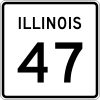







- Kane County Route 17
- Randall Road
Communities
Villages
- Algonquin (part)
- Barrington Hills (part)
- Bartlett (part)
- Big Rock
- Burlington
- Campton Hills
- Carpentersville
- East Dundee (mostly)
- Elburn
- Gilberts
- Hampshire
- Hoffman Estates (part)
- Huntley (part)
- Kaneville
- Lily Lake
- Maple Park (part)
- Montgomery (mostly)
- North Aurora
- Pingree Grove
- Sleepy Hollow
- South Elgin
- Sugar Grove
- Virgil
- Wayne (part)
- West Dundee
Census-designated place
Other unincorporated communities
Townships
- Aurora Township
- Batavia Township
- Big Rock Township
- Blackberry Township
- Burlington Township
- Campton Township
- Dundee Township
- Elgin Township
- Geneva Township
- Hampshire Township
- Kaneville Township
- Plato Township
- Rutland Township
- St. Charles Township
- Sugar Grove Township
- Virgil Township
Politics
As one of the Yankee-settled and prosperous suburban “collar counties”, Kane County was a stronghold of the Free Soil Party in its first few elections, being one of nine Illinois counties to give a plurality to Martin van Buren in 1848. Kane County then unsurprisingly became solidly Republican for the century and a half following that party's formation. It voted for the GOP Presidential nominee in every election between 1856 and 2004 except that of 1912 when the Republican Party was mortally divided and Progressive Theodore Roosevelt carried the county with a majority of the vote over conservative incumbent William Howard Taft.
The gradual shift of the GOP towards white Southern Evangelicals, however, has led the generally moderate electorate of Kane and the other “collar counties” to trend towards the Democratic Party. In 2008, Illinois-bred Barack Obama became the first Democrat to carry Kane County since Franklin Pierce in 1852, and the first ever to win an absolute majority of the county's vote (the previous two Democratic winners, Pierce and James K. Polk in 1844 had both gained only pluralities due to strong Free Soil votes). Obama won a plurality in 2012, and Hillary Clinton improved upon Obama's showing to become the second Democrat to win a majority in 2016.
| Year | Republican | Democratic | Third Parties |
|---|---|---|---|
| 2016 | 41.4% 82,734 | 51.9% 103,665 | 6.7% 13,288 |
| 2012 | 48.6% 88,335 | 49.7% 90,332 | 1.7% 3,058 |
| 2008 | 43.4% 83,963 | 55.2% 106,756 | 1.4% 2,644 |
| 2004 | 55.0% 92,065 | 44.1% 73,813 | 0.9% 1,419 |
| 2000 | 54.5% 76,996 | 42.5% 60,127 | 3.0% 4,282 |
| 1996 | 47.4% 54,375 | 41.8% 47,902 | 10.8% 12,416 |
| 1992 | 43.5% 55,684 | 34.8% 44,568 | 21.6% 27,686 |
| 1988 | 64.1% 66,283 | 35.2% 36,366 | 0.7% 763 |
| 1984 | 69.1% 72,655 | 30.3% 31,875 | 0.6% 629 |
| 1980 | 61.8% 64,106 | 28.0% 29,015 | 10.3% 10,663 |
| 1976 | 62.2% 59,275 | 35.7% 34,057 | 2.1% 2,042 |
| 1972 | 69.9% 64,546 | 29.8% 27,525 | 0.3% 306 |
| 1968 | 61.9% 54,144 | 30.4% 26,609 | 7.6% 6,667 |
| 1964 | 53.3% 46,391 | 46.7% 40,703 | |
| 1960 | 63.8% 55,389 | 36.1% 31,279 | 0.1% 93 |
| 1956 | 72.8% 56,009 | 27.1% 20,848 | 0.1% 59 |
| 1952 | 67.8% 50,801 | 32.1% 24,058 | 0.1% 96 |
| 1948 | 64.4% 39,284 | 34.7% 21,176 | 0.9% 532 |
| 1944 | 62.2% 38,689 | 37.5% 23,362 | 0.3% 185 |
| 1940 | 61.8% 41,949 | 37.8% 25,676 | 0.4% 289 |
| 1936 | 52.6% 33,491 | 44.2% 28,187 | 3.2% 2,051 |
| 1932 | 56.2% 32,934 | 42.0% 24,638 | 1.9% 1,084 |
| 1928 | 69.9% 38,236 | 29.6% 16,184 | 0.5% 253 |
| 1924 | 76.3% 32,717 | 8.2% 3,517 | 15.5% 6,624 |
| 1920 | 82.8% 26,832 | 13.3% 4,323 | 3.8% 1,243 |
| 1916 | 67.7% 23,868 | 28.0% 9,875 | 4.3% 1,506 |
| 1912 | 12.7% 2,415 | 23.1% 4,394 | 64.3% 12,257 |
| 1908 | 70.3% 12,840 | 23.6% 4,316 | 6.1% 1,111 |
| 1904 | 75.6% 12,638 | 16.8% 2,799 | 7.6% 1,271 |
| 1900 | 67.6% 12,031 | 29.5% 5,259 | 2.9% 521 |
| 1896 | 69.9% 12,133 | 28.0% 4,852 | 2.1% 362 |
| 1892 | 53.8% 7,977 | 39.0% 5,778 | 7.2% 1,072 |
See also
Notable people
References
- "Kane County". Geographic Names Information System. United States Geological Survey.
- "State & County QuickFacts". United States Census Bureau. Archived from the original on June 6, 2011. Retrieved July 6, 2014.
- "Find a County". National Association of Counties. Archived from the original on May 31, 2011. Retrieved June 7, 2011.
- Gannett, Henry (1905). The Origin of Certain Place Names in the United States. Govt. Print. Off. pp. 172. Retrieved October 18, 2015.
- "Population, Housing Units, Area, and Density: 2010 – County". United States Census Bureau. Archived from the original on February 12, 2020. Retrieved July 12, 2015.
- "Monthly Averages for Geneva, Illinois". The Weather Channel. Archived from the original on September 9, 2012. Retrieved January 27, 2011.
- "Forest Preserves". Forest Preserve District of Kane County. Archived from the original on December 15, 2018. Retrieved December 13, 2018.
- "Population and Housing Unit Estimates". Retrieved March 26, 2020.
- "U.S. Decennial Census". United States Census Bureau. Retrieved April 16, 2015.
- "Historical Census Browser". University of Virginia Library. Archived from the original on August 11, 2012. Retrieved July 6, 2014.
- "Population of Counties by Decennial Census: 1900 to 1990". United States Census Bureau. Archived from the original on April 24, 2014. Retrieved July 6, 2014.
- "Census 2000 PHC-T-4. Ranking Tables for Counties: 1990 and 2000" (PDF). United States Census Bureau. Archived (PDF) from the original on December 18, 2014. Retrieved July 6, 2014.
- "DP-1 Profile of General Population and Housing Characteristics: 2010 Demographic Profile Data". United States Census Bureau. Archived from the original on February 13, 2020. Retrieved July 12, 2015.
- "DP03 SELECTED ECONOMIC CHARACTERISTICS – 2006–2010 American Community Survey 5-Year Estimates". United States Census Bureau. Archived from the original on February 13, 2020. Retrieved July 12, 2015.
- Leip, David. "Dave Leip's Atlas of U.S. Presidential Elections". uselectionatlas.org. Archived from the original on March 23, 2018. Retrieved July 5, 2017.
- General
- Forstall, Richard L. (editor) (1996). Population of States and Counties of the United States: 1790 to 1990: From the Twenty-One Decennial Censuses. United States Department of Commerce, Bureau of the Census, Population Division. ISBN 0-934213-48-8.CS1 maint: extra text: authors list (link)
External links
| Wikimedia Commons has media related to Kane County, Illinois. |
- Kane County official government website
